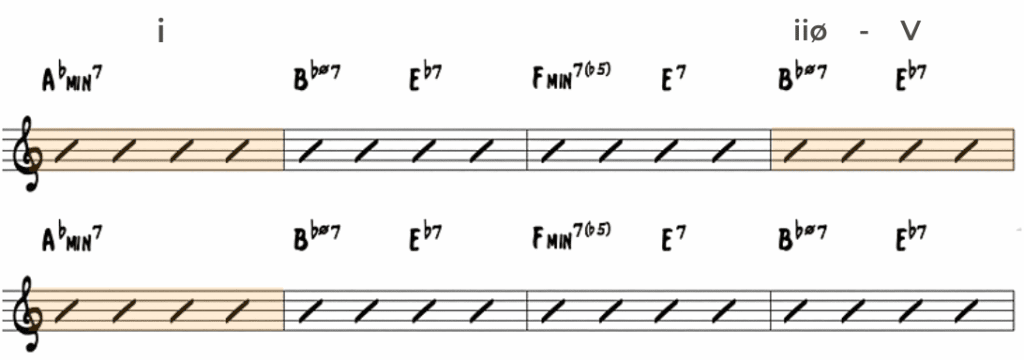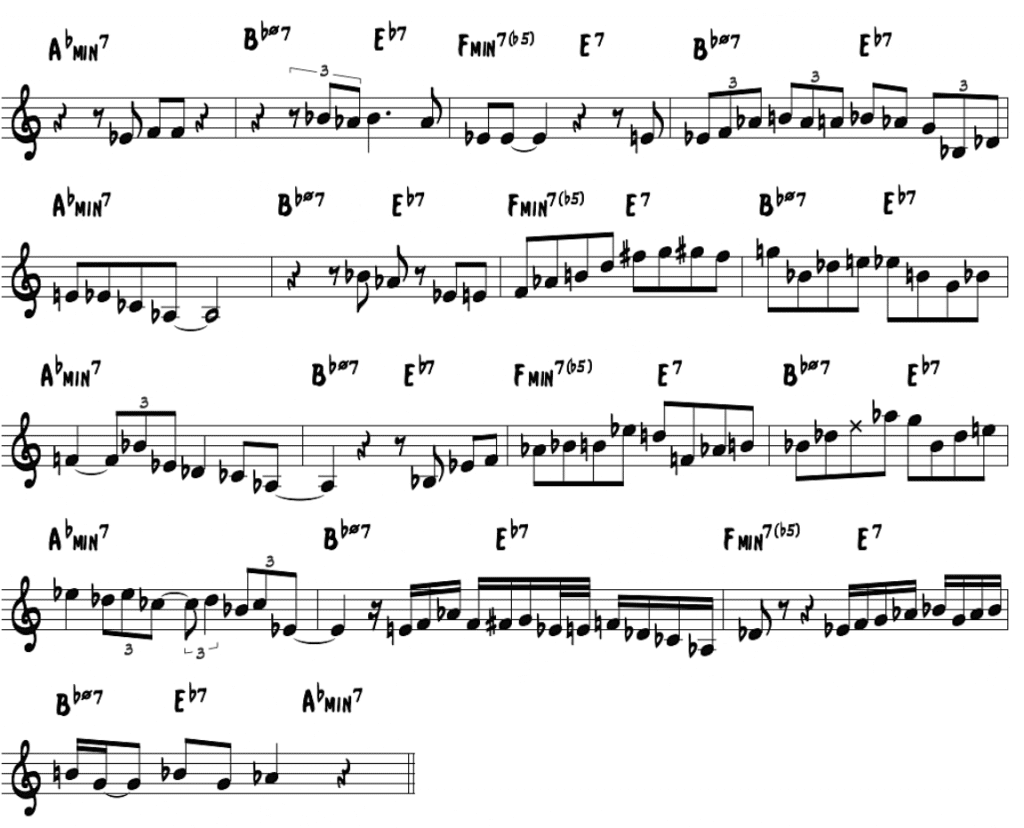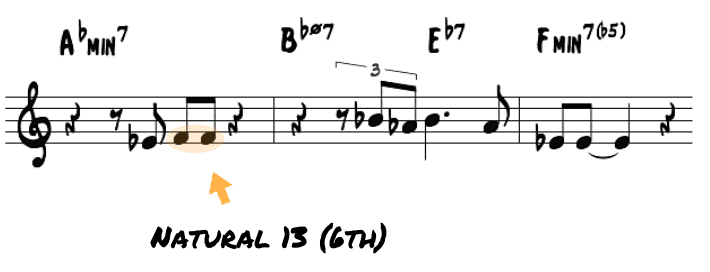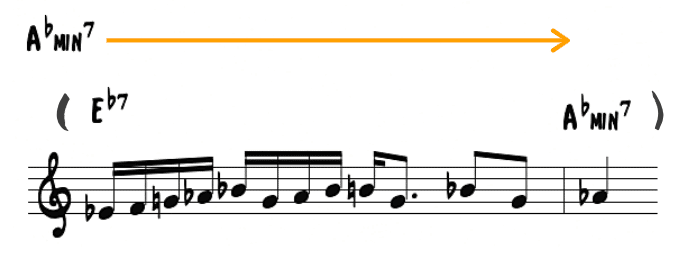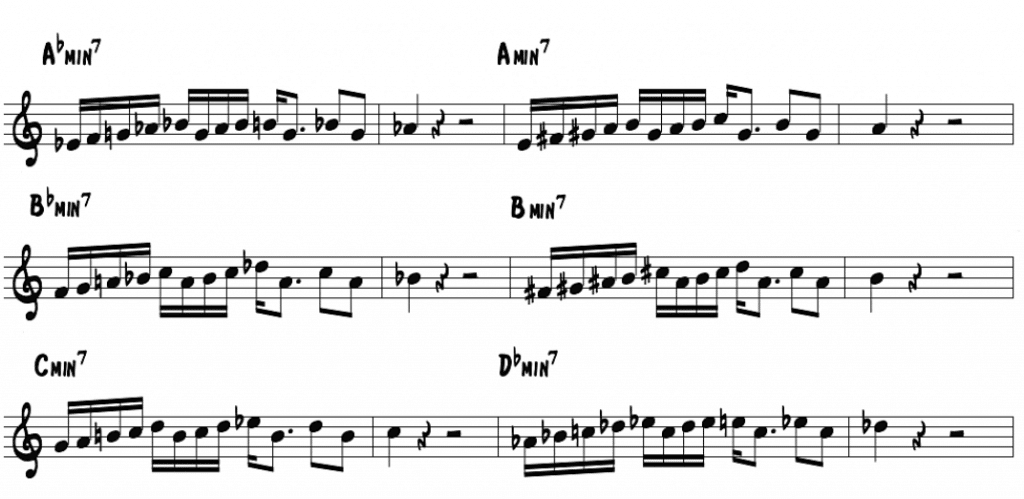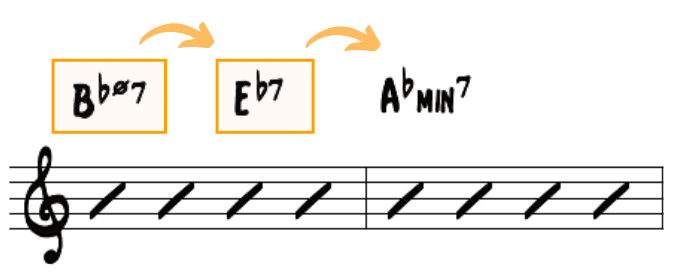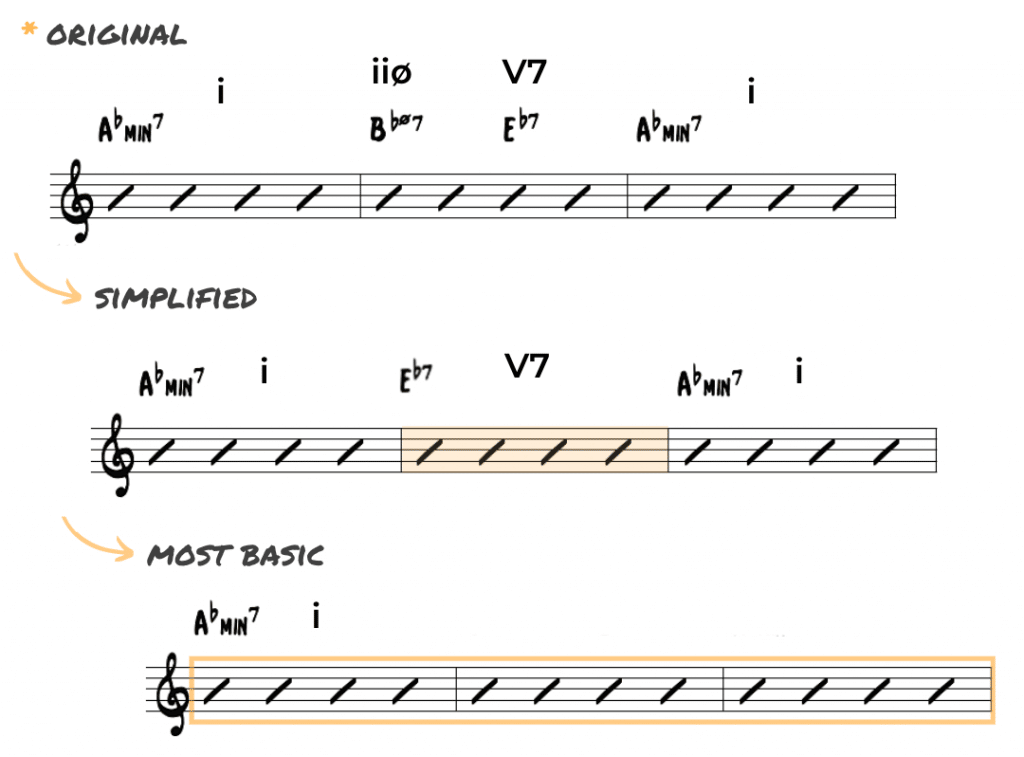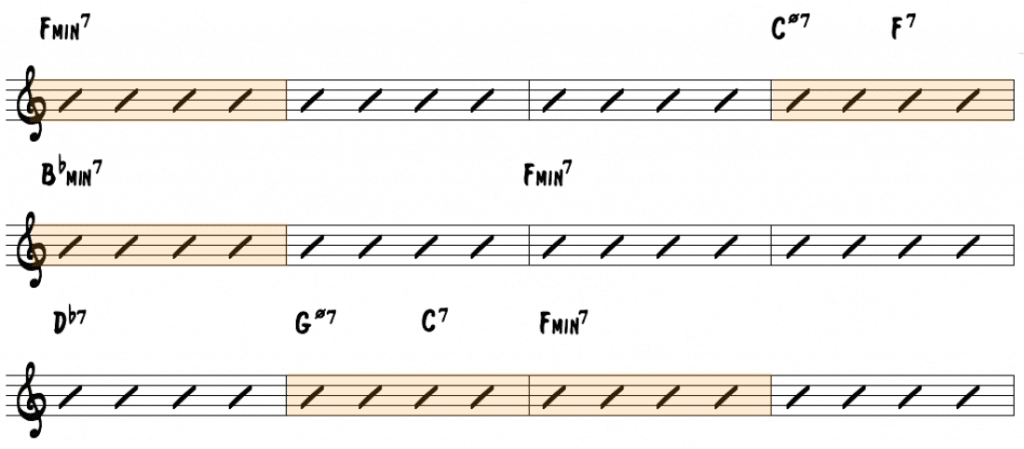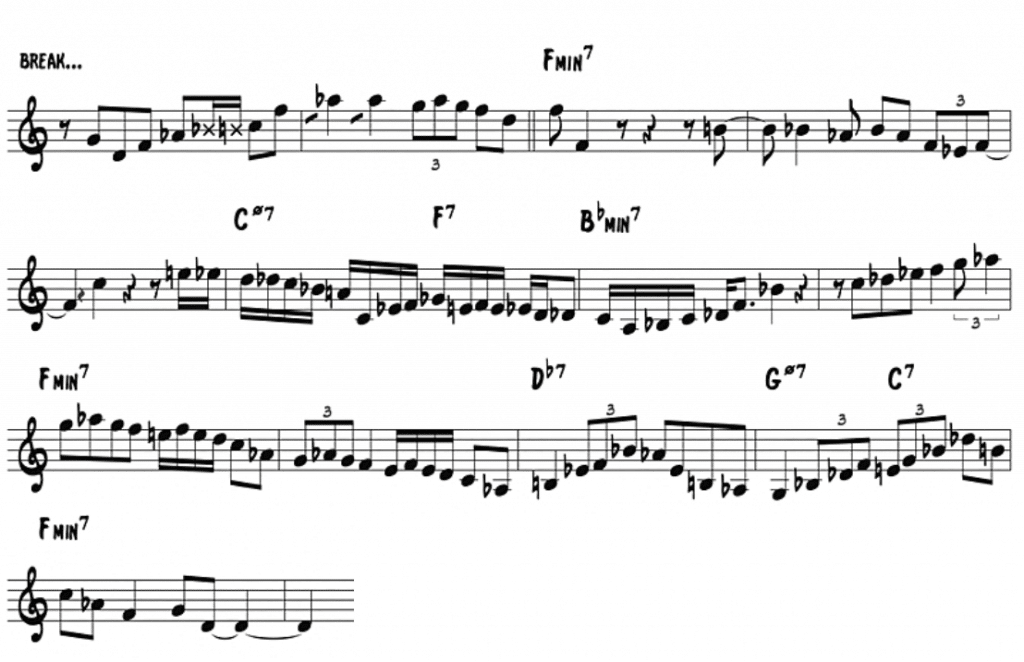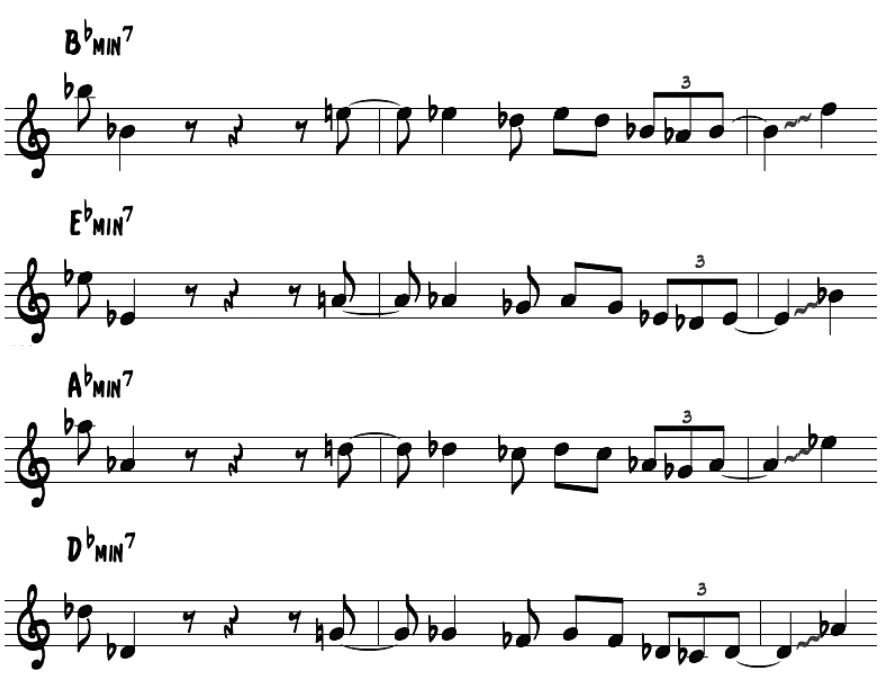Minor chords are found in every style of music, especially in the jazz repertoire. From popular jazz standards and the minor blues, to the ii-V-I progression and the minor vamps that pop up in numerous tunes…
The truth of the matter is if you want to sound good in any sort of musical situation, you need to have more than a scale for improvising over minor chords.
So if you’re still clinging to minor scales, stuck with the same old licks, or simply out of musical ideas over minor progressions, it’s time to get serious about developing your approach to minor chords.
With any musical skill that you wish to acquire, you can’t just wait around and hope that someday it’ll come out of your instrument – you need to actively put it into your playing!
In today’s lesson we’re going to show you how to do this with minor chords and the musical language of a master musician…
Learning from a master
As we outlined in this Premium Guide to Finding and Mastering the Jazz Language, there are a few ways you can approach gathering and learning musical language.
One of the most effective is by selecting your favorite player and isolating specific musical examples from their solos where they are improvising on a particular chord or problem spot that you wish to fix in your playing.
The goal is to determine what specific techniques these players are using and why they are making certain musical decisions. Today we’re going to focus on the musical approach of Clifford Brown.
Specifically, we’re looking for language and improvisation techniques over:
- minor chords
- minor ii-V’s
- general minor language
- other harmonic or melodic minor concepts
Remember, you don’t have to tackle an entire solo to gather important techniques and musical concepts. As we’ll show you below, a single measure or even a few notes can reveal valuable information!
Where to find minor language
Once you have a player selected, the next step is finding solos and musical examples where these musicians are improvising over the particular chords and progressions you’re having trouble with.
Since we’re focusing on minor chords in this lesson, you might search for:
The good news is that minor keys, minor chords, and minor progressions are everywhere in the jazz repertoire! Below, we’ll focus on two tunes from Clifford Brown: Land’s End and Minor Mood.
Let’s take a closer look at these two solos…
Solo excerpt 1: Land’s End
The first tune we’ll look at is the Harold Land composition “Land’s End” from the album Study In Brown, a 32 bar tune in Ab minor. Clifford’s solo begins at 2:05 in the recording:
To start, figure out the chord progression of the tune and identify the areas with minor chords and minor progressions that you want to focus on…
Then transcribe the solo or a few phrases:
From these 16 bars we’re going to isolate and learn some important musical techniques to use over minor chords…
Minor Technique #1 – The natural 13th sound
Each chord tone in any type of chord that you encounter, from Major to minor, has a unique sound. A particular “flavor” within the harmony that you can accentuate in your musical phrases.
On minor chords, one of these chord tones is the natural 13th or 6th:
Check out how Clifford utilizes this unique sound in his solo, starting on the opening Ab- chord…
He begins his phrase with the distinctive sound of the 13th (F) over minor:
He uses this particular sound a few bars later in his solo, again emphasizing a 13th over an Ab minor sound:
To utilize this sound in your own solos, you need to ingrain the sound of the 13th on minor chords. Visualize it in every key, sing it, and play it on your instrument:
The goal is to be able to instantly access this sound over any minor chord that you play. You can do the same with the other chord tones on minor as well, ingraining and emphasizing the sound of the 9th, 11th, or even Major 7th.
Minor Technique #2 – Isolating minor language
As you listen to your favorite players and study their solos, the goal is to not only look for broad harmonic or melodic concepts, you should also be stealing individual lines note for note.
Pieces of musical language – small musical phrases that you can learn and apply to your own solos. Melodic ideas that you can adapt to fit the musical situations you encounter.
Here is one example of minor language from Clifford’s solo…
You can look at this phrase as following the original chord progression notated above, as V7 resolving to i, or simply as a line in the key of Ab minor:
The different ways in which you think about the harmonic movement in this phrase will affect how you apply it to your solos.
To begin, isolate this line and learn it in all keys:
Once you’ve mastered this piece of minor language in all keys, practice applying it to different musical situations in your solos – to minor chords, V7 moving to i, or minor ii-V resolving to i.
Minor Technique #3 – Diminished arpeggios on Ø7 and V7
When you’re playing tunes in minor keys, you are going to encounter the minor ii-V-i progression.
As a result, you need to have some techniques for navigating the two chord types in this progression – Half-diminished (-7b5) and Dominant 7:
One melodic technique Clifford uses to improvise over these two types of chords is diminished arpeggios, (stacks of minor thirds)…
Let’s look at how Clifford uses this technique in the minor ii-V’s from the excerpt above:
On both of the half-diminished (minor7 b5) chords in this example, he plays a diminished arpeggio. Starting on the root of the Fø7 chord and the 6th of the Bbø7:
*You could also look at the Bbø7 chord as the V7 chord (Eb7) for the entire measure leading to i.
Here’s another example over the same sequence a few bars later in his solo. In this excerpt notice how Clifford applies the diminished arpeggios to the V7 chords in the progression:
Over the dominant chords in this progression, Clifford plays a diminished arpeggio that resolves down by half-step to the next chord.
It’s also important to understand that the E7 chord in this progression is a tritone substitution of Bb7:
The diminished arpeggio works over both the original chord and the tritone sub. In the line above Clifford approaches it as a Bb7, starting the diminished arpeggio on the 3rd of the chord – he uses the same pattern on the Eb7 chord.
Practice applying diminished arpeggios to both chords in a minor ii-V progression, varying the direction of the line. Start with Clifford example on V7 chord, playing a diminished arpeggio from the 3rd and resolving to the i chord:
Technique #4 – Phrasing with the big picture in mind
The way you think about the chords and harmonic relationships in a progression will have a direct effect on the way you create musical phrases over it.
It comes down to simplicity vs. complexity. And the truth is, most great improviser are thinking much more simply than you might expect.
To see what I mean, let’s take another look at how Clifford creates a phrase at the beginning of his solo…
Rather than trying to play each individual chord in the first three bars or inserting ii-V licks, he simply creates a musical phrase in Ab minor:
The progression as a whole is in the key of Ab minor and Clifford simply plays in the tonic key. This is a technique you can use to create a more melodic approach to any progression.
As you might have noticed with Clifford’s solo, he doesn’t play every single chord in the progression, and at times he purposefully skips over some chords and ignores others.
Why?? He is mentally simplifying chord progressions. To see what I mean, take a i–iiø-V-i progression in Ab minor. You can approach this harmonic sequence in 3 ways, from complex to progressively more simple…
A ii-V progression can be simplified to the fundamental motion of V7 to I. And the most basic way to look at this entire is simply a progression in the tonic key.
Each of these approaches to the progression will result in a different musical statement and melodic approach, even though you are dealing with the same progression. Let’s go back to the first four bars of Land’s End.
The trap that a lot of players get in is thinking of every single chord and inherent chord tones and trying to play each one moving to the next…
With this mindset it’s easy to get lost in the theory details and forget about the larger harmonic motion at work. You freeze up and struggle to create a melodic idea that moves between the chords.
Instead think about the larger chord movement and harmonic relationships. As you go to improvise and try to create musical phrases based on the bigger “harmonic picture”:
This mental approach to the progressions will allow you to focus on simple melodic phrases and the fundamental harmonic relationships at work. Once you can do this, then it’s time to look at the details.
Aim to look at the larger harmonic motion of a progression, rather than getting hung up on every little detail. Once you have a solid melodic foundation, you can always add more complexity!
Here’s another example of this technique from Clifford’s solo:
Again, instead of adhering to the written chord progression, Clifford plays the bigger harmonic motion of V7 resolving to i:
Aim to simplify your melodic and harmonic approach to chord progressions in your solos, prioritizing melodic statements – remember, there is always room to add complexity and nuance to a great melody!
Technique #5 – Rhythmic Variety
Regardless of the tune or chord progression you’re playing, it’s easy to get stuck in the routine of using constant 8th note lines in your phrases…over and over again.
And this can get predictable and boring, like a lecturer droning on in a monotone voice without any emphasis or variation.
However, just as there are many harmonic techniques to add interest and tension to a line, there are rhythmic techniques you can incorporate to add interest to your musical phrases.
Here are two ways Clifford utilizes rhythm to create interest and variety in his lines…
The first is by incorporating triplets into his phrases. Let’s go back to this line from the first four bars of his solo:
Rather than another string of eighth notes over a minor ii-V, Clifford incorporates triplets to change the feel of the line.
Strive to do this in your own playing. Start by practicing with a metronome and playing groups of triplets. Once you’re comfortable with that, mix 8th note lines with triplets interspersed.
Here’s another example of rhythmic variety later on in the solo. Check out how Clifford uses varied rhythms to create a fluid melodic line…
Remember, in addition to the rhythms you play, your articulation, how you accent and emphasize certain notes, and your overall time feel are central to your musical phrasing.
Solo excerpt 2: Minor Mood
The next Clifford solo over minor that we’ll check out is from Minor Mood, an F minor blues. His solo begins at 0:58 in the video:
Again, start by figuring out the chords and targeting specific spots in the progression that you want to focus on:
Then transcribe a few musical phrases…
With just one chorus of the minor blues, we have enough material for four more minor techniques:
Technique #6 – Applying Blues Language to Minor
When you play a minor chord you don’t have to limit yourself to the notes of a minor scale or the dorian mode. You can also employ blues language…
Listen to how Clifford does this in the opening of his solo:
Rather than a minor scale or arpeggio, he uses blues language – emphasizing the b3, #4, b7, and 11th of the chord in his lines. Try this “blues” approach to minor chords in your own lines.
However, just like a major or minor scale is not a musical statement within itself, remember that a blues scale by itself is not “blues language.” You must play these notes in a musical way, rather than simply inserting a scale.
It’s all about creating melodic statements within a sound. Playing with rhythmic clarity, emphasizing certain blue notes, and creating a logical musical phrase.
Technique #7 – Isolating minor language
Just as you isolated and learned specific pieces of minor language in the examples above, you also need to find specific examples of blues language.
Blues language is versatile in that you can use it over minor chords, dominant chords, and even major chords. A great place to begin is with this Clifford line:
Before you set out to memorize it in every key, understand the construction of the line – which chord tones are used, which notes are emphasized, the rhythmic placement:
This will allow you to effectively learn this piece of language in any keys:
After you have it down, you can apply it to minor chords, dominant chords, major chords, the Blues, Rhythm Changes, etc.
Technique #8 – Minor ii-V-i Language
Along with minor language and blues language, you also need language for the minor ii-V progression.
Check out the minor ii-V line Clifford plays at the end of his first chorus on Minor Mood:
In this line, he is essentially arpeggiating each chord in the progression – starting on the root of the Gø7 chord, the 3rd of C7, and descending from the 5th of the F-7.
Notice how Clifford resolves each chord by half-step motion and changes direction in the phrase.
*This line also combines many of the concepts that we’ve covered so far: Diminished arpeggios over iiø and V7, emphasizing the 13th on minor.
Another piece of minor ii-V language to learn is the line below, a double-time line that Clifford plays going into the iv chord:
Note how he uses chromaticism and enclosure to extend line. Start by breaking this line down into pieces and analyzing what Clifford is doing on each beat, then piece it together and learn it in all keys.
Now it’s your turn…
All of the techniques above are valuable tools for your approach to minor chords and progressions.
Remember, the examples above are just from the first chorus of Clifford’s two solos…and within those, there’s more techniques there that we didn’t cover!
With these ten techniques in mind, listen to the rest of each solo and see if you can hear these techniques in Clifford’s phrases. Listen for and learn:
- Specific chord tones used on minor chords
- Minor language
- Minor ii-V language
- Phrasing techniques
- Rhythmic approach
- Blues language
Some of these ideas are relatively simple and others are bigger concepts that will take time to incorporate into your musical approach…
However, all of these techniques will improve your ability to play over any minor chord that you encounter in any solo!


